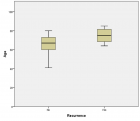Table of Contents
Is beta 2 urinary microglobulin a biomarker of topographical discrimination between high and low urinary tract infection?
Published on: 28th April, 2020
OCLC Number/Unique Identifier: 8588737014
Urinary tract infections are common affection in the general population.
Diagnosis is often easy in the presence of evocative clinical signs.
The diagnosis of urinary tract infection is evoked in the presence of an uropathogenic germ in the urine in sufficient quantity associated with urinary signs. The presence of lower back pain, chills, fever higher than 39° is suggestive of a high urinary tract infection localized in the kidney, the absence of fever associated with dysuria is suggestive of low urinary tract infection localized in the bladder.
Meanings of microalbuminuria in idiopathic nephrotic syndrome in children
Published on: 13th April, 2020
OCLC Number/Unique Identifier: 8582370066
We investigated the existence of microalbuminuria in children with corticosteroid-sensitive idiopathic nephrotic syndrome in complete remission. In the study of a series of 18 cases, we noted a clearly different evolution depending on the existence or absence of pathological micro albuminuria.
Microalbuminuria appears to be a prognostic discrimination parameter in idiopathic nephrotic syndrome.
Persistent hydronephrosis after pyeloplasty: Is it a true obstruction? The role of endourology
Published on: 13th April, 2020
OCLC Number/Unique Identifier: 8582316817
Introduction: Anderson-Hynes pyeloplasty remains the gold standard in the treatment of ureteropelvic junction obstruction. The diagnostic criteria for defining the failure of pyeloplasty are not well-defined or even arbitrary. Likewise, the ideal treatment of persistent hydronephrosis after pyeloplasty is not well established. We tested an innovative endourological procedure, which simultaneously allows a diagnostic definition of failure and treatment when necessary.
Materials and methods: The endourological procedure was applied prospectively to 13 cases from 2006 to 2015. The mean hydronephrosis was 3 cm and all the patients showed an obstructive pattern at scintigraphie. Of these, only 2 patients had symptoms. The procedure consisted in the endoscopic calibration of the pyeloureteral junction. In case of confirmed persistent stenosis, the procedure continued with the high pressure dilation of the junction. The calibration/dilation procedure was carried out with a balloon catheter, previously used for high pressure dilation in the obstructive megaureter. In all patients, a ureteral stent was positioned for 6 - 8 weeks.
The patients were then followed up using ultrasound and renoscintigraphie.
Results: According to the endoscopic balloon procedure, anastomosic stenosis was confirmed in 3 cases, treated with high pressure dilation during the same procedure. In 10 cases no stenosis was found and we followed-up these patients with periodic ultrasound and scintigraphie.
Conclusion: The calibration/dilation of the pyeloureteral junction represents in our opinion a useful diagnostic and therapeutic tool that allows to limit the repetition of open surgery only to symptomatic cases and those non-responders to endoscopic treatment.
A remote cause of anuria in a child
Published on: 26th February, 2020
OCLC Number/Unique Identifier: 8582359236
Acute renal injury is a rare complication of idiopathic nephrotic syndrome with mesPGN. Here we present a 2-year-old male patient with 4 days history of anuria, generalized edema and hypervolemia. Any evidence other than proteinuria and renal failure could not be identified with laboratory tests and doppler ultrasonography. Anuric presentation was thought to be related with rapidly progressive glomerulonephritis, diffuse mesangial sclerosis or acute tubular necrosis. However, renal biopsy revealed mesangial proliferative glomerulonephritis (mesPGN). Prednisolone 2 mg/kg/day was prescribed. Diuresis was started gradually and on the 10th day of disease, anuria was resolved and acute renal injury recovered without any sequel. This case is presented because of the incompatibility between clinical findings and histopathologic diagnosis. It is concluded that although rare, anuria and acute renal injury could be the presenting symptom of idiopathic nephrotic syndrome in childhood.
Granulomatosis with polyangiitis (GPA) in a 76-year old woman presenting with pulmonary nodule and accelerating acute kidney injury
Published on: 20th January, 2020
OCLC Number/Unique Identifier: 8516756417
Granulomatosis with polyangiitis (GPA), a form of ANCA-associated vasculitis (AAV), is a rare disease with an often-occult presentation. It is more common in 4th and 5th decades of life but can be seen in all ages.
This case report details a 76-year-old female presenting with abdominal pain, generalized weakness, and malaise, who was found to have pulmonary nodules on chest imaging. Biopsy of the lung nodule showed organizing pneumonia. Initially, antibiotics were used to treat the patient. However, she developed acute renal failure a few days after presentation and found to have positive serum C-ANCA as well as elevated ANCA-PR3 serologies. A subsequent kidney biopsy demonstrated pauci-immune necrotizing and crescentic glomerulonephritis that was consistent with GPA and the patient was started immediately on combination immunosuppressive therapy, plasmapheresis, and hemodialysis.
GPA’s clinical and radiological presentation can mimic other common conditions such as pneumonia, malignancy, bacterial sinusitis, pulmonary tuberculosis, sarcoidosis, and urinary tract infection. Because of this, a high level of suspicion is required for early diagnosis and treatment to alter the high mortality rate in this disease entity. All forms of ANCA-associated vasculitis (AAV) should be in the differential diagnosis for all patients presenting with multiorgan system involvement particularly in individuals with pulmonary and renal manifesations.

HSPI: We're glad you're here. Please click "create a new Query" if you are a new visitor to our website and need further information from us.
If you are already a member of our network and need to keep track of any developments regarding a question you have already submitted, click "take me to my Query."





















































































































































